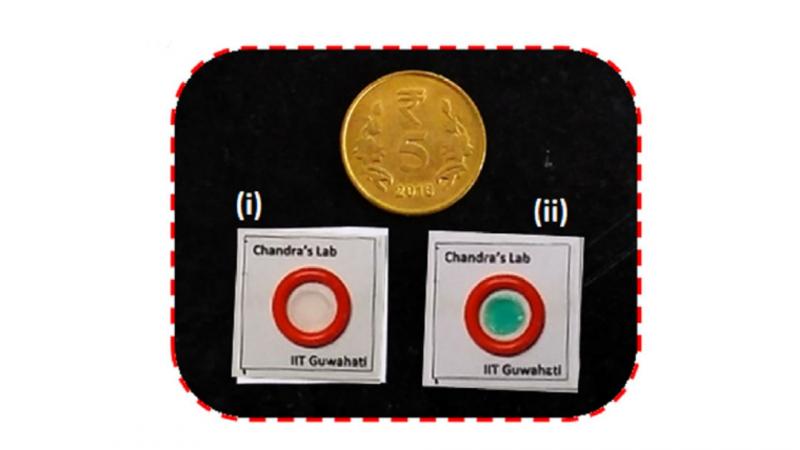
Biosensors designed by researchers at IIT Guwahati to detect alkaline phosphatase in raw milk [Image Source]
In this digital age, ruled by smartphone apps, how about one to tell you how fresh your milk is? Although there are stringent safety rules concerning the quality of milk, almost 68% of what is available in the country does not conform to them. In a recent study, researchers at the Indian Institute of Technology Guwahati have come up with a paper-based detection system to detect if a sample of milk is pasteurised and fresh. This technique, they say, is cost-effective, rapid, user- and environment-friendly.
Raw milk is pasteurised, by rapid heating and cooling, to kill harmful microbes present in it. Conventionally, to ensure that the milk you consume is well-pasteurised, sophisticated instruments and multiple time-consuming procedures are followed. This approach restricts the ability to detect the quality of milk on-site. In the current study, the researchers have used small discs of filter paper as biosensors to identify a compound called alkaline phosphatase in milk samples. The study has been published in the journal Biosensors and Bioelectronics and is funded partly by the Department of Science and Technology.
Alkaline phosphatase (ALP) is a protein found in high concentrations in raw milk. On pasteurisation, it is denatured, and thus, pasteurised milk is ideally devoid of it. When this protein comes in contact with the sensor probe designed by the researchers, it generates a blue-green precipitate in the presence of its substrate 5-bromo-4-chloro 3-indolyl phosphate, as a result of the characteristic catalytic reaction, indicating that the milk is unpasteurised.
The coin-sized working prototype of the sensor consists of the paper disc, which is chemically treated and has alkaline phosphatase antibody attached to it. It is then placed on a cellulose acetate transparent film. A ring enclosing it serves as the area where the biochemical reaction happens, and also provides mechanical strength to the whole assembly, which is then covered with another cellulose acetate film.
The researchers captured this change in colour on the paper discs using a smartphone camera and processed the images to obtain the corresponding RGB (Red-Green-Blue) values. They compared these values with a threshold value to measure the amount of alkaline phosphatase present in the milk sample.
"We are on the verge of publishing an app to integrate this technique with a smartphone to improve the fabricated biosensor", says Dr Pranjal Chandra, an author of the study.
The researchers also verified if any other molecules, naturally present in milk, such as citric acid, bovine serum albumin, lactose, casein, vitamins and other ions also resulted in a similar change of colour, and found none. Hence, the designed sensor has high selectivity towards alkaline phosphatase.
The miniaturised, instrument-less, and commercially-viable sensor can detect alkaline phosphatase in small concentrations of about 0.87 units per millilitre. In comparison, alkaline phosphatase in raw milk contains about 191 units at the point of collection. It can do this in a mere 13 minutes, without the need for any additional instruments. The researchers have successfully used their sensor to samples of raw milk from villages as well as those of pasteurised milk.
"The detection kit is robust and easy-to-use. However, if it is not transported with care, the assembly can be damaged, and that will eventually compromise the performance,” warns Dr Chandra. "As of now, we estimate that the biosensor could cost anywhere between USD 1-1.5. This cost will certainly decrease after mass production", he says.
The researchers claim that the application of this biosensor lies beyond just milk. "The sensing platform described in this study can be extended towards the detection of other molecules too", says Dr Chandra, talking about the future prospects of the research.
This article has been run past the researchers, whose work is covered, to ensure accuracy.





